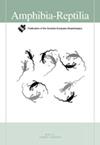Ashes still smoking: the influence of fire and land cover on Pantanal ecoregion amphibians
IF 1
4区 生物学
Q3 ZOOLOGY
引用次数: 0
Abstract
Fire and land cover are two elements intertwined with the natural history of organisms from seasonally dry environments. Here, we investigated the influence of fire attributes (burned area and frequently-burned area) and land cover on the relative abundance of three amphibians from the Pantanal ecoregion that belong to distinct ecomorphological groups: Chiasmocleis albopunctata, Pseudis platensis, and Scinax acuminatus. We systematically reviewed amphibian ecology studies in the Pantanal and analysed quantitative data between 2000 and 2021, comprising 34 sites from 12 amphibian surveys. Amphibian abundance, land cover, and fire data were assessed within buffers of a 1000 m radius. Species abundance was correlated with burned area and wetland cover. While the abundance of C. albopunctata and P. platensis decreased with burned area in the last three years, the abundance of S. acuminatus increased with wetland cover. Despite the claimed resilience of species inhabiting grasslands and savannas, there was substantial evidence for the influence of burned areas, even under modest human land use. Our findings illustrate that a broad array of land cover and fire attributes may influence amphibian persistence in the Pantanal ecoregion, with the magnitude depending on species traits often overlooked in modelling approaches.灰烬仍在冒烟:火灾和土地覆盖对潘塔纳尔生态区两栖动物的影响
火灾和土地植被是与季节性干旱环境中生物的自然史交织在一起的两个因素。在这里,我们研究了火灾属性(烧毁面积和经常烧毁面积)和土地覆盖对潘塔纳尔生态区三种两栖动物相对丰度的影响:Chiasmocleis albopunctata、Pseudis platensis 和 Scinax acuminatus。我们系统地回顾了潘塔纳尔地区的两栖动物生态学研究,并分析了 2000 年至 2021 年期间的定量数据,包括 12 项两栖动物调查的 34 个地点。对半径为 1000 米的缓冲区内的两栖动物丰度、土地覆盖和火灾数据进行了评估。物种丰度与焚烧面积和湿地覆盖率相关。在过去三年中,C. albopunctata 和 P. platensis 的数量随着焚烧面积的增加而减少,而 S. acuminatus 的数量则随着湿地覆盖面积的增加而增加。尽管栖息在草原和热带稀树草原上的物种被认为具有顽强的生命力,但有大量证据表明,即使在人类适度使用土地的情况下,焚烧区也会对其产生影响。我们的研究结果表明,一系列广泛的土地覆盖和火灾属性可能会影响两栖动物在潘塔纳尔生态区域的持久性,影响程度取决于建模方法中经常忽略的物种特征。
本文章由计算机程序翻译,如有差异,请以英文原文为准。
求助全文
约1分钟内获得全文
求助全文
来源期刊

Amphibia-Reptilia
生物-动物学
CiteScore
3.10
自引率
6.20%
发文量
39
审稿时长
6-12 weeks
期刊介绍:
Amphibia-Reptilia is a leading European multi-disciplinary journal devoted to most of the aspects of herpetology: ecology, behaviour, evolution, conservation, physiology, morphology, paleontology, genetics, and systematics.
Amphibia-Reptilia publishes high quality original papers, short-notes, reviews, book reviews and news of the Societas Europaea Herpetologica (SEH). The Societas Europaea Herpteologica (SEH) website is located at: www.seh-herpetology.org.
 求助内容:
求助内容: 应助结果提醒方式:
应助结果提醒方式:


